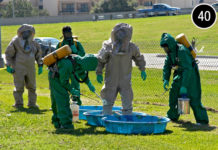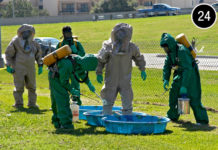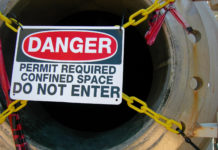Workers who work in hot environments indoors or outdoors, or even those engaged in strenuous physical activities, may be at risk for heat stress.
The different types of heat illness include: heat exhaustion, heat syncope, heat cramps, heat rashes, and heat stroke. Heat can also increase workers’ risk of injuries, as it may result in sweaty palms, fogged-up safety glasses, dizziness, and may reduce brain function responsible for reasoning ability, creating additional hazards.

Workers who are exposed to extreme heat or work in hot environments indoors or outdoors, or even those engaged in strenuous physical activities may be at risk for heat stress. Occupational exposure to heat can result in injuries, disease, reduced productivity, and death.
Exposure to extreme heat can result in occupational illnesses caused by heat stress, including heat stroke, heat exhaustion, heat syncope, heat cramps, heat rashes, or death. Heat can also increase workers’ risk of injuries, as it may result in sweaty palms, fogged-up safety glasses, dizziness, and may reduce brain function responsible for reasoning ability, creating additional hazards.
Other heat injuries, such as burns, may occur as a result of contact with hot surfaces, steam, or fire. Those at risk of heat stress include outdoor workers and workers in hot environments, such as fire fighters, bakery workers, farmers, construction workers, miners (particularly surface miners), boiler room workers, and factory workers.
- Training provides an overview of OSHA, workplace hazards, workers' rights, employer responsibilities, and how to file a complaint. Required by some states and companies in order to start employment on a worksite.
- 10hr only $89 - 30hr only $169!
- Enter Promo Code "osha15offF" at Checkout
OSHA Heat Prevention
The National Integrated Heat Health Information System (NIHHIS) can help decision makers prepare for extreme heat events days, months, and years in the future.
Risk Factors for Heat Illness
Many outdoor workers are in good physical health, but several factors can increase their risk of suffering from heat illness:
- high temperature and humidity
- direct sunlight
- limited air movement (no breeze)
- moderate to heavy exertion
- heavy personal protective equipment
- dehydration
- some medications
- other sources of heat (furnaces, ovens, exhaust)
In some cases, heat-related illness can occur in temperatures as low as the 70s (°F).

Types of Heat Illness
The U.S. Centers for Disease Control (CDC) identifies the following five main types of heat illness:
1. Heat Stroke
Heat stroke is considered the most serious heat-related illness, occurring when the body can no longer regulate its temperature. The body temperature quickly rises and the ability cool off by sweating often fails. Heat stroke can cause death or permanent disability in the absence of emergency treatment.
- Symptoms: Hot, dry skin; hallucinations; chills; throbbing headache; high body temperature; confusion/dizziness; slurred speech.
- First Aid: Call 911 and notify supervisor; move affected worker to shaded area; take steps to cool the individual (spraying with water, fanning).
2. Heat Exhaustion: As a response to excessive loss of water and salt, the body may experience heat exhaustion. Those who are elderly or have high blood pressure are particularly vulnerable.
- Symptoms: Heavy sweating; extreme weakness; dizziness/confusion; nausea; clammy skin; pale complexion; muscle cramps; slightly elevated body temperature; fast, shallow breathing.
- First Aid: Have worker rest in a cool or shaded area; give worker plenty of water and have them take a cool bath, if possible.
3. Heat Syncope
Heat syncope is an episode of dizziness or fainting that can occur with prolonged standing or from suddenly standing from a sitting position. This can occur as a result of dehydration or a lack of acclimatization.
- Symptoms: Light-headedness; dizziness; fainting.
- First Aid: Have affected worker sit in a cool place once they feel symptoms, in addition to slowly drinking water or a sports beverage.
4. Heat Cramps
Heat cramps typically are a result of low salt levels in muscles as a result of excessive sweating. They also may be a symptom of heat exhaustion.
- Symptoms: Muscle pain or spasms, usually in the abdomen, arms or legs.
- First Aid: Stop activity and sit in a cool place; drink clear juice or a sports beverage; abstain from strenuous work for a few hours; seek medical attention if the worker has heart problems or the cramps don’t subside after one hour.
5. Heat Rash
Heat rash is a skin irritation caused by excessive sweating.
- Symptoms: Appears as a red cluster of pimples or small blisters; likely to occur on the neck, upper chest, groin, under the breasts and in elbow creases.
- First Aid: Keep worker in cooler, less humid environment; keep affected area(s) dry; use dusting powder, if available.
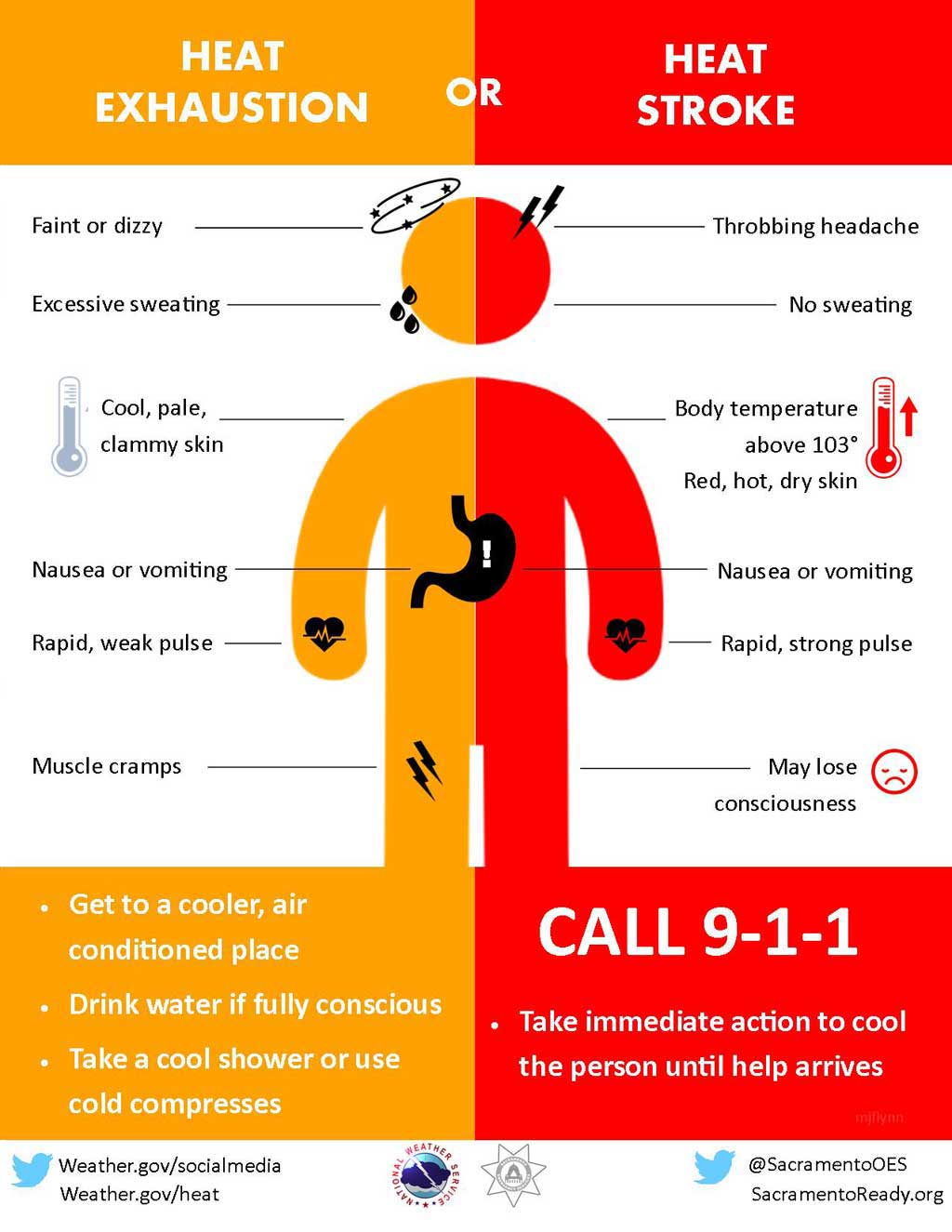
Heat Stress – Health and Safety Training
A heat stress training program should be in place for all who work in hot environments and their supervisors. Workers and supervisors should be trained about the prevention and first aid of heat-related illness before they begin work in a hot environment and before heat index levels go up.
Heat prevention training should be reinforced on hot days. Prevention of heat-related illnesses depends on early recognition of the signs and symptoms of impending heat-related illness and initiation of first aid and corrective procedures at the earliest possible moment.
OSHA Heat Illness Prevention Training Guide
- A guide for employers to carry out heat safety training, with lesson plans (tailgate or toolbox talks).
- Available in English (PDF) and Spanish (PDF)
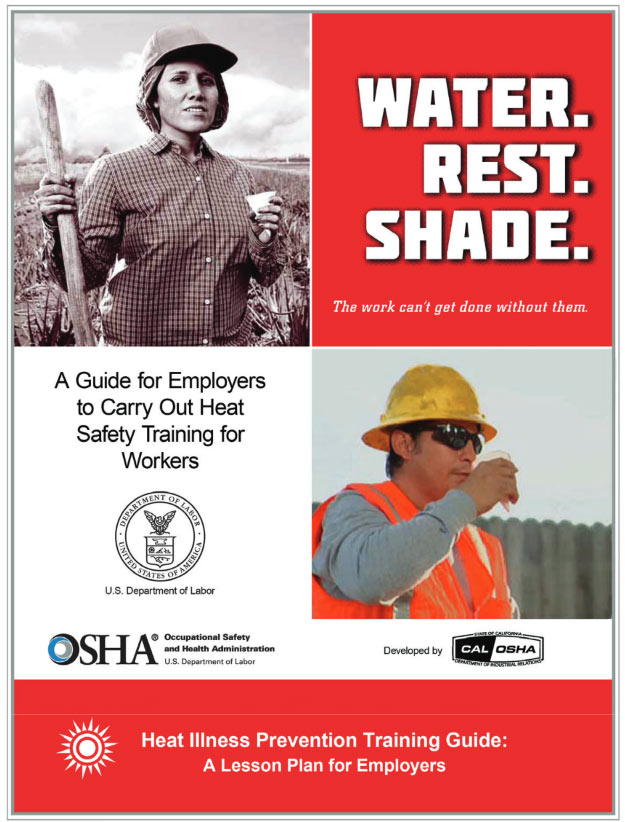
Summary
Many outdoor workers get uncomfortably hot during summer. Employers are responsible for providing a safe workplace – free from unsafe exposure to heat that can result in injuries, disease, reduced productivity, and death.
Heat Safety Resources for Worker and Employers
Supervisors: Preventing heat-related illness in your workers requires a commitment to monitoring daily temperatures, continual awareness of workers’ level of effort, and heat-illness prevention training.
Workers: Learn to recognize signs that you or your coworkers need to cool down. Be ready to seek help if you or your coworkers are disoriented, confused, or slurring speech.
- OSHA’s Heat Health site offers a free smartphone app to help people monitor their risk of heat illness as well as fact sheets and posters in English and Spanish.
- OSHA-NIOSH offers an INFOSHEET (PDF) describing symptoms and treatments for heat illness.
- The Heat Stress Chapter of OSHA’s Technical Manual offers definitions and examples to help supervisors manage heat hazards.
- National Integrated Heat Health Information System (NIHHIS) can help decision makers prepare for extreme heat events days, months, and years in the future.
- Centers for Disease Control – Extreme Heat and Your Health provides information for populations that are vulnerable to high heat, a media toolkit to help spread the word about heat hazards, and other heat-health resources.
- National Weather Service – Heat Safety Site offers heat safety tips and resources for on the job, indoors, outdoors, and in vehicles.
- CDC Guide: Criteria for a Recommended Standard: Occupational Exposure to Heat and Hot Environments (PDF)
- UPDATED from NIOSH: Criteria for a Recommended Standard – Occupational Exposure to Heat and Hot Environments
- Protecting Workers from the Effects of Heat Fact Sheet (PDF). OSHA Fact Sheet (Publication 3743), (August 2014).
- Protecting Workers from Heat Illness (PDF). OSHA-NIOSH Heat Illness Info Sheet, (2011).
- Occupational Heat Exposure. OSHA Safety and Health Topics Page.
- Protecting Yourself From Heat Stress. NIOSH Fast Facts (Publication 2010-114), (April 2010).
- Heat Stress. NIOSH Workplace Safety and Health Topics.
- Frequently Asked Questions (FAQs) about Extreme Heat. Centers for Disease Control and Prevention (CDC) Emergency Preparedness and Response.
- Beat the Heat: Heat Safety Resources. National Oceanic & Atmospheric Administration’s (NOAA) National Weather Service.
- California Campaign to Protect Outdoor Workers From Heat Illness.*** Cal/OSHA.
- Heat Illness Prevention.*** Cal/OSHA, Division of Occupational Safety and Health (DOSH).
- Heat Illness Prevention eTool.*** Cal/OSHA.
- Quick Facts for Employees (PDF) (English and Spanish). Oregon OSHA (QF-008 OR-OSHA).
- Outdoor Heat Exposure (OHE, Heat Stress).*** Washington State Department of Labor and Industries.
- Website and “Don’t Fry Day”. National Council on Skin Cancer Prevention (NCSCP).
- Sun Safety. Centers for Disease Control (CDC) Skin Cancer.







